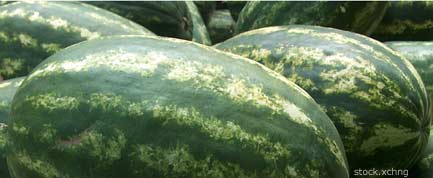Powerful Ideas: Cars Could Run on Watermelons

Editor's Note: This occasional series looks at powerful ideas — some existing, some futuristic — for fueling and electrifying modern life.
Watermelon juice could become the newest renewable energy source for vehicles, scientists now suggest.
Each year, about 1 out of 5 watermelons are left behind in fields because they are misshapen or because of cosmetic blemishes. In the 2007 growing season, this amounted to roughly 360,000 metric tons of lost melons in the United States alone.
Researchers at the U.S. Department of Agriculture now suggest these reject watermelons, which are currently just plowed back into the field, could find use in biofuel.
The scientists propose the sugar in these melons can be fermented into ethanol — more commonly known as drinking alcohol — which is finding increasing use as a fuel worldwide. Watermelon juice makes up roughly half the weight of a melon, and this juice is up to 10 percent readily fermentable sugar.
In experiments, scientists found they could efficiently convert the sugars in watermelon juice into ethanol. They estimate roughly 26 liters of ethanol could be made per metric ton of rejected watermelons.
"A field of watermelons can yield somewhere between 30 to 60 tons per acre of watermelon, so a fifth of that can be impressive," said researcher Wayne Fish, a chemist with the Agricultural Research in Lane, Oklahoma.
Get the world’s most fascinating discoveries delivered straight to your inbox.
A watermelon field can range in size from small family-operated units of roughly 20 to 30 acres to commercial production fields of 100 to 1000 acres, Fish added. A watermelon seed producer also informed him that acres of the melons are regularly grown just for the seeds, ignoring all else. "You can imagine the juice from that would be substantial as well," he said.
Although watermelons by themselves will not solve the nation's daunting fuel needs, Fish noted "this represents a small piece of a giant puzzle." For instance, leftovers from other crops that might otherwise go to waste could be converted into fuel as well. "I've gotten calls from Mexico wanting to talk about the agave plant, which is used to make tequila and is very high in sugars. So people in Mexico and the desert parts of the United States could take advantage of that."
In addition to biofuel production, the researchers noted watermelon juice could be a source of two commercially valuable "nutraceuticals," or food extracts thought to have medicinal effects. These are lycopene, a powerful antioxidant that gives watermelons their red color and has been shown to be important in prostate health, and L-citrulline, an amino acid involved in detoxifying ammonia and dilating blood vessels.
Since it could prove very expensive to haul watermelons to biofuel facilities, "particularly with the way fuel prices were last summer, if the mountain won't come to Mohammed, why not bring Mohammed to the mountain and process the watermelons right in the field?" Fish said.
Fish envisioned a traveling fermentation system that goes from farm to farm "like a mobile schnapps machine." Some growers will probably keep any ethanol they make for use in their own home operations to cut down on fuel costs, he said, while others will sell it on the market. He added biofuels company Common Sense Agriculture in College Station, Texas, is now devising such a mobile unit.
Fish admitted, "We tasted what we made. The problem is that with the fermentation that we're doing, we're trying to get the most fuel in the shortest amount of time, so we tend to make some fusel oils, which are not conducive to a pleasant taste and aroma."
Fish added, "We do have enough in a bottle at about 190 proof for people to see and smell and touch. It kicks like a mule."
Fish and his colleagues detailed their findings online August 26 in the journal Biotechnology for Biofuels.



